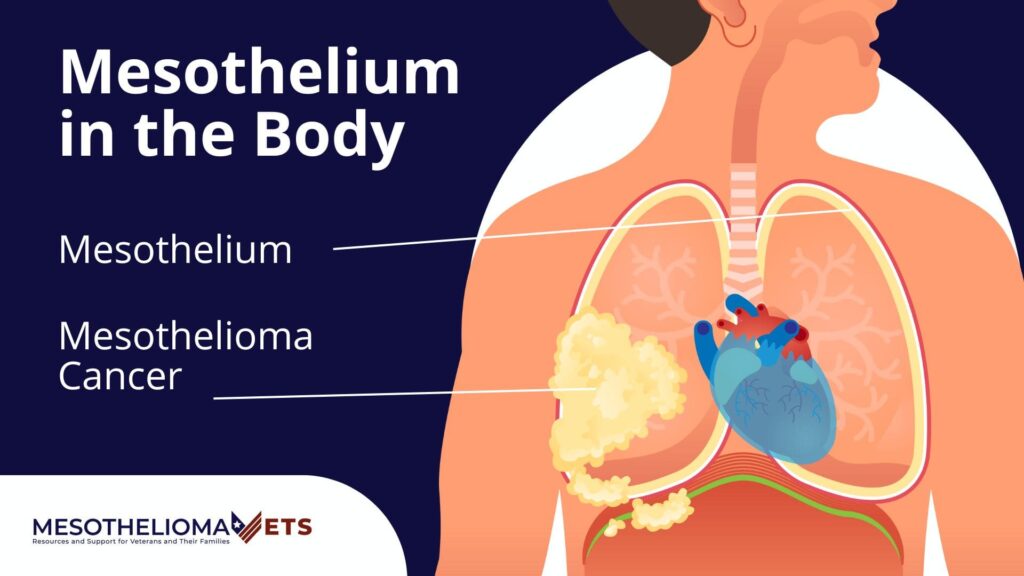The Mesothelium and Mesothelial Cells Explained
The mesothelium is a protective membrane made of mesothelial cells that coats the lungs, abdomen, heart, and testes. After prolonged exposure to asbestos, people can develop mesothelioma cancer in the mesothelium. Veterans are at an elevated risk of coming into contact with asbestos and developing an asbestos-related disease

What Is the Mesothelium?
The mesothelium is one continuous thin layer of mesothelial cells. The three primary regions that make up the tissue are the pleural, the peritoneum, and the pericardium. The pleura lines the lungs and chest cavity, while the peritoneum forms the lining around the abdominal organs and abdominal wall. Lastly, the pericardium lines the heart and thoracic cavity.
Mesothelium tissue serves as a slippery protective layer that also helps transport fluid and cells across cavities in response to injury or infection-caused inflammation. Two layers make up the mesothelium: the visceral layer and the parietal layer. The visceral layer covers the organ, while the parietal layer covers the body cavities.
Mesothelial cells vary in size and shape. The shape of a found mesothelial cell can range from flat to cuboidal. The size of a mesothelial cell can reach about 10 to 50 micrometers in diameter and 1 to 4 micrometers in thickness.
Medical Issues Involving this Tissue
Injury to the mesothelium can cause medical issues such as cancer. Asbestos-related diseases like mesothelioma occur after damage to the mesothelium via asbestos exposure. Asbestos is a fibrous mineral that causes cancer after significant exposure occurs.
When disturbed, asbestos fibers become airborne and can enter the body through inhalation or ingestion. The fibers become lodged into the mesothelial lining of the chest, heart, or stomach. During a time frame of 10 to 40 years, the lodged fibers irritate the tissue, causing damage and inflammation over time.
Damage and inflammation of the mesothelium can result in adhesions (scar tissue). These changes can cause the mesothelial cells to mutate and turn into malignant mesothelioma cells. Exposure to asbestos also causes asbestosis, lung cancer, and ovarian cancer.
Effusions involving any of the areas containing mesothelium tissue happen as a result of primary diseases like cancer, surgery, or an infection. As stated by medical professionals in cancer treatment centers, Pleural effusions occur when fluid builds up between the two layers of the pleural mesothelium. Peritoneal effusions accumulate fluid in the abdomen, and pericardial effusions accumulate fluid in the tissue surrounding the heart.
The mesothelium can experience other issues, including:
Pleura Medical Issues
- Inflammation of the pleura (pleuritis)
- Pleural plaques
- Pleural thickening
- Atelectasis (underinflated lungs)
Peritoneum Medical Issues
- Inflammation of the peritoneum (peritonitis)
- Primary peritoneal serous carcinoma
Pericardium Medical Issues
- Inflammation of the pericardium (pericarditis)
- Lymphoma cancer
- Sarcoma cancer
- Primitive neuroectodermal tumors
- Compression of the heart (cardiac tamponade)
Protecting the Mesothelium
While all risk factors of mesothelioma cannot be avoided, they can be explained, and you can reduce your risk by taking steps to limit asbestos exposure. Avoid areas with old asbestos products that appear to be damaged. A building or home built before 1980 may still contain asbestos.
Veterans who served in any branch of the military were likely exposed during their service. Taking steps to monitor the health of their mesothelium can help detect cancer and other asbestos-related conditions sooner. People with a history of exposure may use monitoring tools like diagnostic imaging tests (x-ray) or a pulmonary function test to measure lung function.
